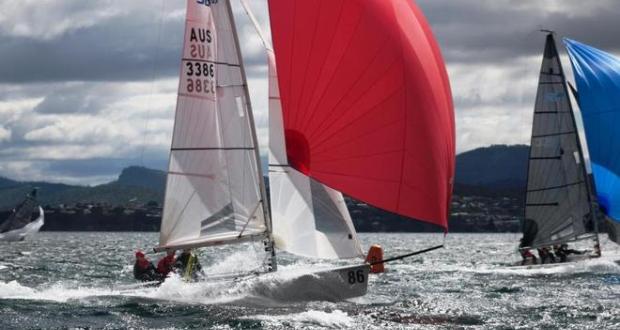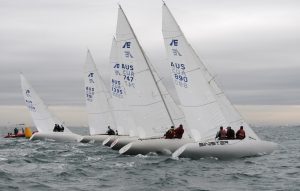

All team members must know how to communicate your performance in a fleet.
Comparing your performance to another competitor during a race is an underrated part of sailing a boat competitively.
It’s important to talk about what is happening on your boat, but even more important to communicate what’s happening relative to your nearest competitors.
Immediately After the Start.
It’s essential to start calling your relative position to your competition as soon as possible after the start. The first few minutes are a critical boatspeed part of the race, and the sooner your team can get locked in, the better.
Identify which boat you are calling relative positions against. As an example, “I have us with (name of boat, or bow number or name of skipper)”. Knowing who you are gauging performance against is important.
Always refer to your boat first. For example, say, “Higher, same speed.” To avoid any confusion, don’t refer to them first. If they are higher than you, state, “We are lower.”
When you are about To Tack or Gybe in Heavy Traffic.
When calling a tack or gybe with boats around you, the helmsperson needs to know where you would likely end up. Would you be behind them? Would you cross them? Would you hit them amidships?
If you must tack or gybe for tactical reasons and a collision is possible, alert the crew that after tacking, they will need to steer down and ease momentarily to cross behind a boat. It is essential to also name the boat to avoid confusion.
Common Calling/Communication Errors and Remedies
- We start the race, and nobody says anything. Silence is deadly, and we come off the line in a low mode that is not optimal VMG. To fix that, we need to identify who we are calling relatives against and make it clear how your team is going against them.
- We don’t take note of the True Wind Direction or heading before starting the relative calls. We state we are losing a lot to the boats above us, oblivious to the fact that the wind has lifted us 15 degrees. We start changing settings to try to improve based on the feedback, but we only perform worse and lose a lot. The fix is to make sure that you always note the TWD and heading before comparing boat relatives.
- We aren’t going well, so we stop calling relatives. Nothing is done to address the performance issue, and we lose places because of it. To fix that, be consistent, be honest and keep the process the same throughout the race.
- The boat above you has a poor start, and now they are in your quarter waves, going even slower. You keep calling relatives on them because they are closest to you. Your team thinks they are going well based on your calls. But the boat you are calling is compromised. To fix this, make sure that you cast your eye around the fleet and check your performance relative to all boats around you.
Conclusion
It’s important to compare your relative performance against all your competitors, not just the boat in your immediate vicinity. When you do so, be clear, confident, accurate and consistent.
If there is no one left to call relatives against, hike hard and do your best with all maneuvers. Continue to roll tack, set gybe and drop spinnakers as efficiently as possible and carry out tacking and mark rounding as though you were under boat-on-boat pressure.

